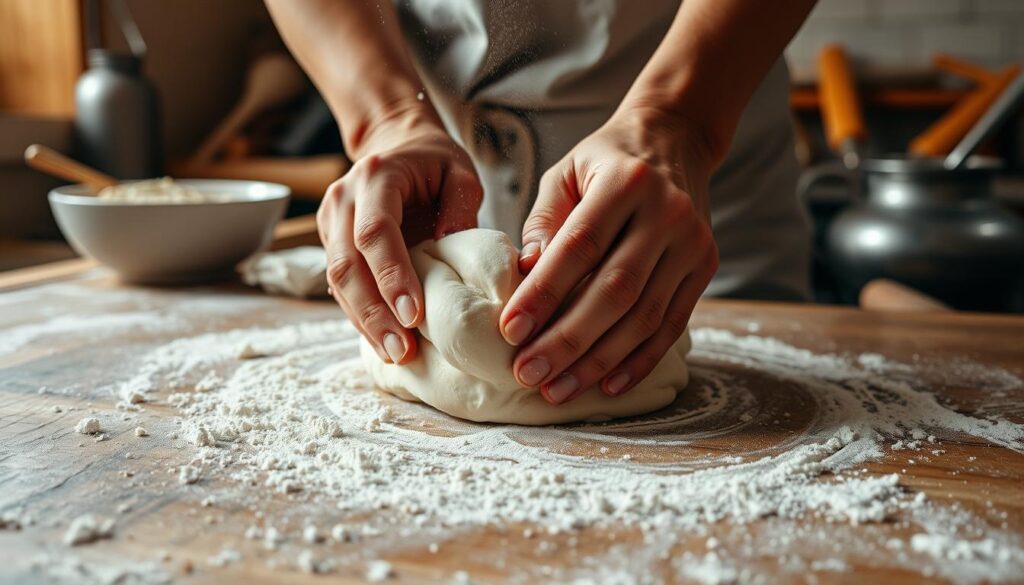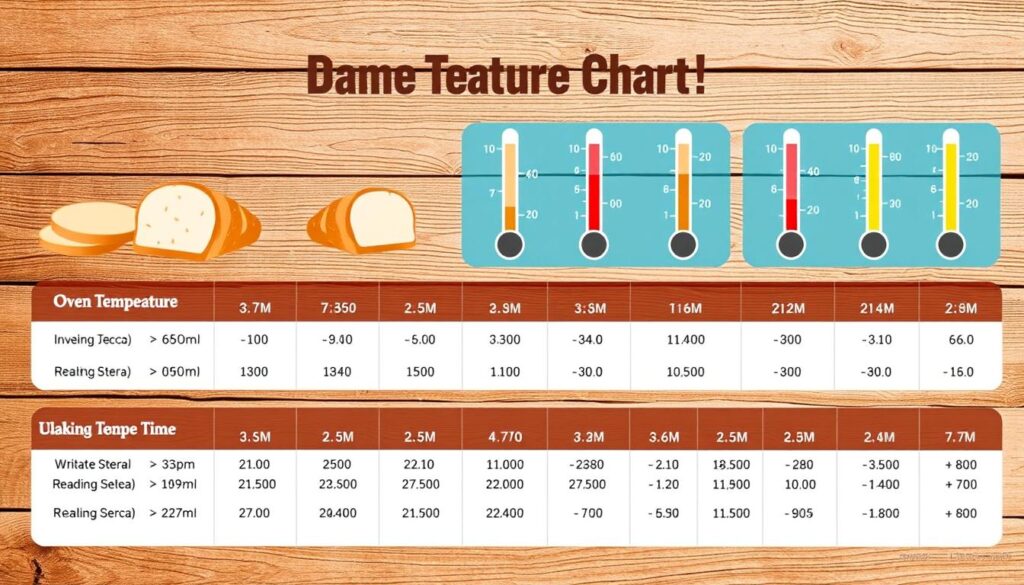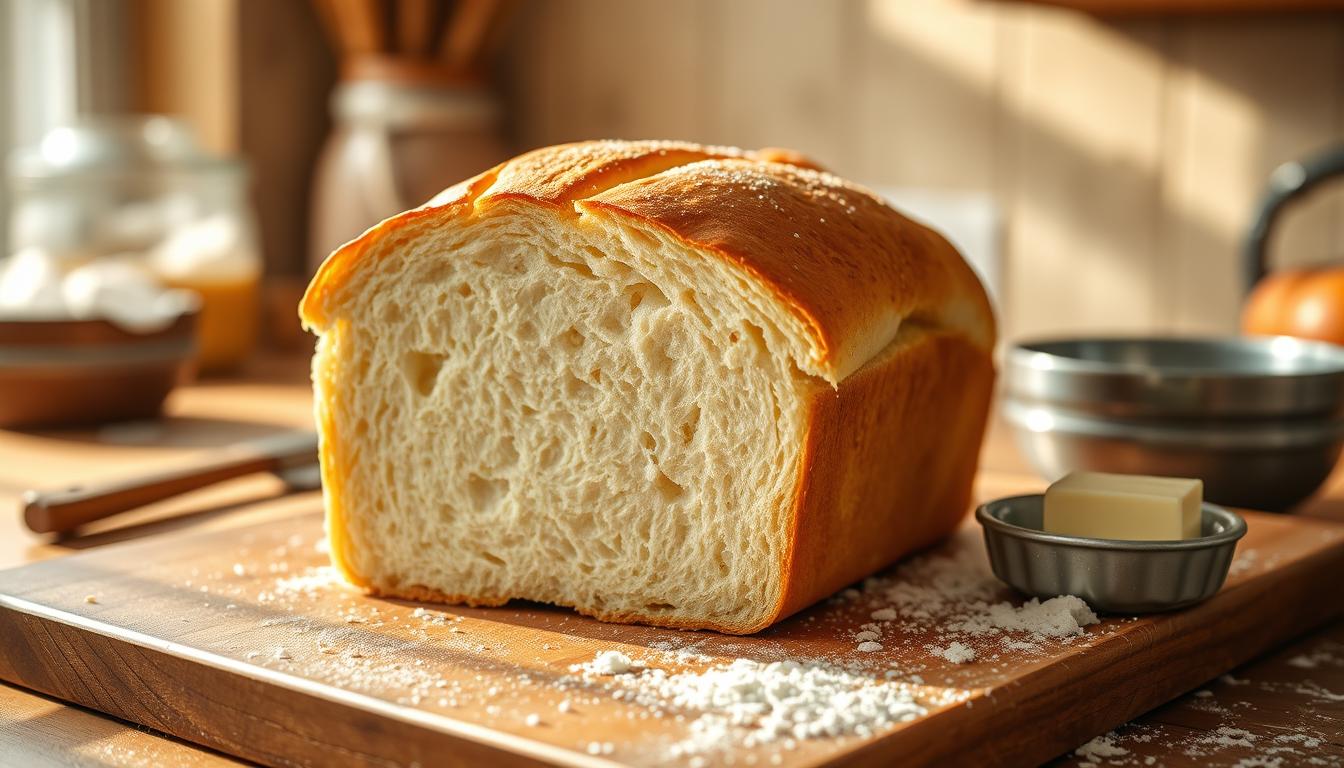Bread Classice White: Every kitchen has a special rhythm, passed down through family recipes. For me, kneading homemade classic white bread is that rhythm. It’s a tradition that brings warmth and love into our homes.
Baking your own classic white bread is magical. The golden crust makes your kitchen warm and inviting. It’s a way to connect with our culinary past, whether you’re experienced or just starting out.
This recipe uses simple ingredients like flour, milk, and yeast. It creates a classic white bread that’s both delicious and full of history. Each slice is a story of patience, skill, and joy.
Key Takeaways
- Homemade white bread offers unmatched flavor and freshness
- Basic ingredients create an extraordinary culinary experience
- Baking bread is a skill that connects generations
- Fresh bread transforms any meal into a special occasion
- Baking can be a therapeutic and rewarding process
Understanding the Timeless Appeal of White bread classice white
White bread is a big part of American bread culture. It’s found in kitchens all over the United States. Its history shows how American food and traditions have changed over time.
Historical Significance in American Homes
Bread making has been loved in American homes for many years. White bread is popular because it’s easy to make and can be used in many ways. In the early 1900s, it was seen as a sign of modern life and new food-making technology.
« White bread represents more than just a food item – it’s a cultural icon that connects generations of American families. » – Food Historian
Bread Classice White: The Evolution of Bread Making
The way we make bread has changed a lot over the years. New technology has made making white bread easier and cheaper for families everywhere.
- Industrial bread production started in the late 1800s
- New ways of making bread made it better
- Using the same ingredients made it taste the same every time
Bread Classice White: Why White Bread Remains Popular
White bread still wins over American hearts with its softness and taste. It’s loved even with all the new bread choices out there. This shows how much it’s a part of American food culture.
People love white bread for its:
- Comforting taste
- Smooth feel
- Being great for sandwiches and toast
- Bringing back memories of old meals
Bread Classice White: Essential Ingredients for Perfect White Bread
Making the perfect white bread starts with knowing its key ingredients. Each part is vital for a delicious, soft loaf. It will make your taste buds happy and your kitchen smell amazing.
Bread Classice White: High-Quality Flour Selection
Choosing the right flour is the first step. All-purpose flour is the base of classic white bread. It gives the bread its structure and texture.
For the best results, pick a high-quality unbleached all-purpose flour. It should have a protein content between 10-12%. This ensures your bread is soft yet strong.
- King Arthur Unbleached All-Purpose Flour recommended
- Protein content matters for bread texture
- Aim for 5 ½ to 6 cups of flour per recipe
Bread Classice White: The Role of Yeast and Salt
Active dry yeast is key for bread making. It needs warm water, 105-110°F, to activate. This makes the dough rise and adds flavor.
Usually, two packets of active dry yeast are best for a standard recipe. Salt also plays a big role. It enhances taste, controls yeast, and strengthens gluten.
« The magic of bread is in its simplicity and the transformation of basic ingredients. » – Artisan Baker
Bread Classice White: Dairy and Fat Components
Bread fats add flavor and make the crumb tender. You can use melted butter, vegetable oil, or milk. About 2-3 tablespoons of butter or 1/4 cup of oil per loaf works well.
| Ingredient | Quantity | Purpose |
|---|---|---|
| Butter | 2-3 tablespoons | Adds richness and flavor |
| Milk | 1/2 cup | Enhances softness |
| Sugar | 3 tablespoons | Feeds yeast, adds slight sweetness |
The secret to great white bread is in the quality of your ingredients. They must work well together. Experiment to find your perfect mix!
Bread Classice White: Step-by-Step Bread Classic White Making Process
Making homemade bread is all about precision and care. It starts with getting your ingredients ready. Then, you follow key steps to turn simple ingredients into a delicious loaf.
« Bread baking is an art that transforms basic ingredients into a comforting masterpiece. » – Professional Baker
Here’s how to make classic white bread in easy steps:
- Yeast Activation
- Use warm water (below 110ºF)
- Combine active dry yeast with sugar
- Wait 5-10 minutes until foamy
- Ingredient Mixing
- Combine milk, water, activated yeast
- Add sugar, salt, and butter
- Gradually add bread flour
- Kneading Techniques
- Knead for 6-8 minutes by hand
- Use a stand mixer for consistent results
- Make the dough smooth and elastic
Your dough needs two rising periods. The first rise takes 1-2 hours, making the dough double in size. After punching it down, shape it into a log and put it in a greased loaf pan for the second rise. This takes about 60 minutes.
| Stage | Duration | Goal |
|---|---|---|
| First Rise | 1-2 hours | Double dough volume |
| Second Rise | 60 minutes | Crown loaf pan |
| Baking | 30-35 minutes | Golden brown crust |
Professional bakers suggest using King Arthur unbleached bread flour for the best results. Bake at 375-400ºF. This ensures a golden-brown crust and an internal temperature of about 185ºF.
Bread Classice White: Mastering the Kneading Technique
Kneading is key in bread making. It turns a messy mix into a smooth, elastic dough. Knowing how to knead can make your bread light and airy.

Hand Kneading Methods
Hand kneading takes patience and practice. Begin on a floured surface. It’s important to notice how the dough changes as you knead.
- Work the dough with the heel of your hands
- Fold and press repeatedly for 8-10 minutes
- Maintain a steady rhythm
- Listen for the sound of the dough changing
Machine Kneading Tips
Stand mixers make kneading easier and keep the dough consistent. Here’s how to use one:
- Use the dough hook attachment
- Knead at medium-low speed
- Monitor kneading time (5-7 minutes)
- Watch for smooth, elastic texture
Signs of Properly Kneaded Dough
Knowing when dough is perfectly kneaded takes time. The windowpane test is the best way to check.
| Test Method | Correct Indication |
|---|---|
| Windowpane Test | Thin, translucent stretch without tearing |
| Elasticity | Smooth, bouncy surface |
| Surface Texture | Barely sticky, holds shape |
« The art of bread making is in the hands, the feel, and the patience of the baker. » – Unknown Baker
Pro tip: Try different water levels to find new bread textures. Remember, the more you practice, the better you’ll get at kneading!
The Art of Dough Rising and Proofing
Learning about dough fermentation is key to making perfect homemade bread. Yeast makes your simple ingredients turn into a tasty loaf. During bread proofing, you’ll see your dough change in amazing ways.
The rising process has two important stages that affect your bread’s quality:
- First Rise (Bulk Fermentation)
- Put kneaded dough in a lightly greased bowl
- Cover with a clean kitchen towel
- Let it rest for 1-2 hours
- Second Rise (Final Proofing)
- Shape dough into a loaf
- Put in a greased loaf pan
- Let it rise for 60 minutes
To succeed in dough fermentation, know how your dough acts. A well-proofed dough will slowly spring back when pressed. Your finger should leave a small dent that bounces back, showing the yeast’s work.
« Patience is the secret ingredient in bread making » – Professional Baker’s Wisdom
Temperature is crucial for yeast activation. The best proofing temperature is 75-80°F. This ensures good fermentation without harming the yeast. Keep your dough away from drafts and sunlight for the best results.
Baking Temperature and Timing Guidelines
Making the perfect white bread needs careful baking techniques. These techniques turn raw dough into a golden, tasty loaf. Knowing the right bread baking temperature and timing is key to making bakery-quality bread at home.
Optimal Oven Settings
The best bread baking temperature is between 350°F to 375°F. Experts say to set your oven to 375°F for the best results. It’s important to preheat well to bake evenly and ensure the bread is done right.
- Preheat oven to 375°F
- Use center rack for uniform heat distribution
- Avoid temperature fluctuations during baking
Visual Cues for Doneness
Checking if bread is done isn’t just about the time. Look for these signs:
- Golden-brown crust color
- Firm, rounded top
- Slightly pulling away from pan edges
« A perfectly baked bread speaks to your senses before you even take a bite. »
Internal Temperature Testing
For exact bread doneness, use a digital instant-read thermometer. The internal temperature should hit 190°F at the loaf’s center.
| Baking Stage | Temperature | Duration |
|---|---|---|
| Oven Temperature | 375°F | 30-35 minutes |
| Internal Bread Temperature | 190°F | Indicates Doneness |

Keep in mind, baking time can change based on your oven and loaf size. Always check with multiple signs to make sure your bread is perfectly baked.
Nutritional Profile and Health Considerations
White bread has a mix of calories and carbs. A slice has about 75 calories. It gives quick energy because of its carbs.
- Protein content: Around 2.57g per slice
- Carbohydrate intake: Approximately 13-14g per slice
- Total calories: Roughly 75 calories per slice
« White bread provides quick energy but lacks the comprehensive nutritional profile of whole grain alternatives. » – Nutrition Experts
White bread has some nutritional value. But, it’s missing many nutrients found in whole grain bread. To make up for this, white bread is often enriched with vitamins and minerals.
| Nutrient | Amount per Slice |
|---|---|
| Calories | 75 |
| Protein | 2.57g |
| Carbohydrates | 13-14g |
People watching their carbs should limit white bread. Moderation is key for a balanced diet. Try whole grain options to get more nutrients.
Health experts say to balance white bread with healthier foods. This helps avoid health problems from too many refined carbs.
Storage Tips and Shelf Life
Keeping your homemade bread fresh is all about the right storage. Knowing how to store bread can make your loaf last longer.
The shelf life of bread depends on several things. Homemade bread stays fresh for up to three days when stored right. Each bread type has its own storage needs, affecting its freshness and texture.
Room Temperature Storage
Here’s how to keep bread fresh at room temperature:
- Store bread in an air-tight container or plastic bag
- Keep it away from direct sunlight and heat
- Don’t refrigerate, as it can make bread stale faster
Freezing Methods
Freezing bread is a great way to keep it fresh longer. Here are some tips for freezing bread:
- Make sure bread is cool before freezing
- Slice it before freezing for easier use
- Use double-layer protection to avoid freezer burn
| Bread Type | Room Temperature Shelf Life | Freezer Shelf Life |
|---|---|---|
| White Bread | 3-4 days | Up to 3 months |
| Sourdough | 4-5 days | Up to 3 months |
| Whole Grain Bread | 2-3 days | Up to 3 months |
Preventing Staleness
To keep bread from getting stale, try these tips:
- Let bread cool completely before storing
- Use an air-tight container
- Avoid cutting bread until you’re ready to eat it
« Proper storage is key to maintaining the texture and flavor of your homemade bread. » – Bryan Quoc Le, Food Scientist
Pro tip: Frozen bread can be thawed at room temperature or quickly reheated in the oven to restore its fresh-baked texture.
Serving Suggestions and Pairings
White bread is a versatile canvas for meals. It can turn simple dishes into something special. Your sandwiches can be anything from classic to gourmet, making every meal a delight.
Here are some ways to make your meals more exciting with white bread:
- Classic Grilled Cheese Sandwiches
- French Toast Breakfast Delights
- Open-Faced Savory Toast Toppings
- Elegant Tea Sandwiches
- Comfort Food Paninis
Pairing white bread with different spreads and ingredients can make your meals unforgettable. Here are some great pairings:
| Spread/Topping | White Bread Pairing | Calories |
|---|---|---|
| Pimiento Cheese | Classic White Bread | 280 calories |
| Buffalo Chicken Dip | Toasted White Bread | 345 calories |
| Cream Cheese | Lightly Grilled White Bread | 215 calories |
Pro tip: White bread is perfect for both sweet and savory dishes. It can be the highlight of your breakfast or dinner, making every meal exciting and tasty.
« Good bread is the most fundamentally satisfying of all foods. » – James Beard
Common Troubleshooting Tips
Bread baking problems can be frustrating, even for experienced bakers. Solving dough troubles needs patience and a deep understanding of bread making. Every challenge is a chance to get better and make perfect loaves.
Yeast issues are a common problem. Here are some key tips to tackle bread-making troubles:
- Check yeast freshness before starting
- Verify water temperature (between 100-110°F)
- Ensure proper proofing environment
- Understand humidity’s impact on dough
« Bread making is an art that rewards careful attention and practice. » – Artisan Baker’s Wisdom
Here are some dough troubleshooting tips for common bread baking problems:
| Problem | Potential Solution |
|---|---|
| Dense Bread | Knead longer, allow more rising time |
| Flat Loaves | Check yeast activity, verify proofing conditions |
| Tough Crust | Lower oven temperature, reduce baking time |
Professional bakers suggest using metric weights for better ingredient measurement. A stand mixer with a dough hook can make mixing easier, especially for those who bake often.
Remember, bread making is a skill that grows with practice. Don’t get discouraged by early failures. Every loaf brings you closer to mastering the art of homemade bread.
Conclusion
Making homemade bread does more than just please your taste buds. It turns simple ingredients into a warm, comforting food that links you to baking traditions of the past. The joy of baking comes from mastering the techniques that make a basic mix into a perfect loaf.
White bread has changed from a symbol of industrial food to a canvas for creativity in the kitchen. Even with ongoing debates about nutrition, fortified white bread stays a favorite in American homes. With practice, you can improve your baking and make loaves that are as good as those from a bakery.
Bread making is an art that needs patience and passion. Each loaf is a chance to try new techniques, ingredients, and flavors. Whether you’re making a classic sandwich bread or trying something like Japanese milk bread or French baguette, your homemade bread will add warmth and joy to your meals.
Enjoy the journey, celebrate your wins, and savor the tasty outcomes of your bread-making journey. Your kitchen will fill with the amazing smell of fresh bread, creating lasting memories with every slice.

